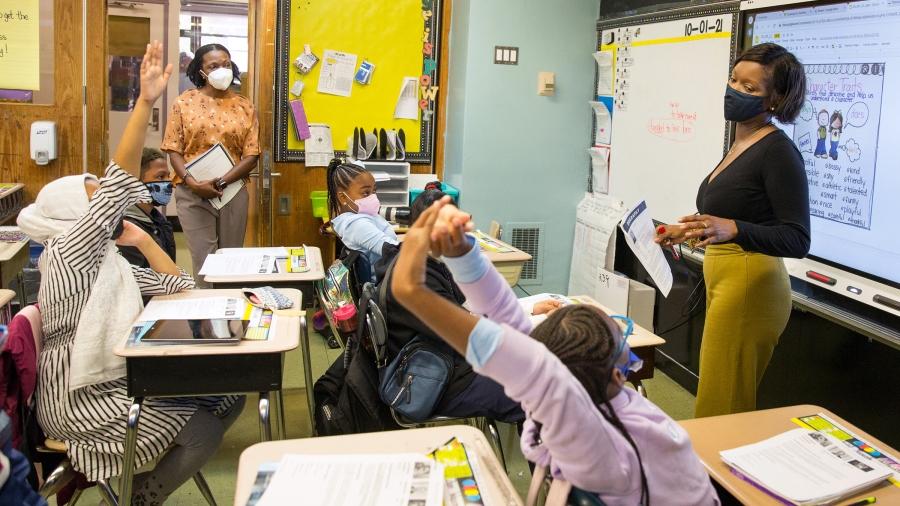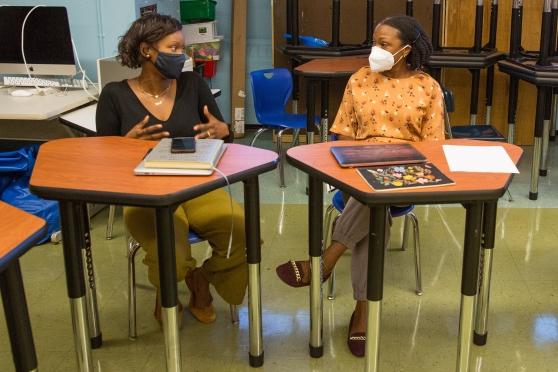Another assist for PIP

Special education teacher Erica Boyce learned how to harness the energy in her integrated co-teaching classroom at PS 677 in Brooklyn with help from the UFT’s Peer Intervention Program — better known as PIP.
It used to annoy Erica Boyce that her 4th-graders at PS 677 in Brooklyn talked so much in class.
That is, until she learned how to harness that energy.
Boyce, a special education English language arts teacher in an integrated co-teaching classroom, recently led a discussion about American Red Cross founder Clara Barton, who was at the helm of the humanitarian organization for 23 years. Hands shot up in the air as she asked for definitions of “financial” and “resign” and other words in Barton’s story.

Boyce reached out to PIP last year for help adjusting to her ICT classroom.
Then she tossed out a question that drew the class together.
“Clara Barton took no salary,” Boyce said. “Would you work for no money?”
“No!” the students said in unison.
“I ask questions to make sure they’re listening and asking questions, too,” said Boyce. “They love talking, so I’m going to use that — use what I always complained about!”
How to harness the energy in her classroom is one of the lessons Boyce learned through the UFT’s Peer Intervention Program (PIP). Since 1988, PIP has helped educators reexamine, refresh and sharpen their skills in the classroom with the help of a peer intervenor, an experienced educator who can help a fellow professional regain their footing through a collaborative relationship built on trust and confidentiality.
“Intervenors work on pedagogy, presentation skills, student management, professional responsibilities and all that it means to be a New York City teacher,” said Jonelle Carter, the PIP intervenor who works with Boyce. “Erica has been wonderful to work with. She wanted to benefit from a peer and to learn.”
Lynne Kilroy, the program coordinator, said intervenors go into classrooms and “meet teachers where they are. It is intensive, one-on-one pedagogical support. We want to help people love teaching again.”
After working with PIP, Kilroy said, teachers have gone on to become chapter leaders, coaches, supervisors and mentors to other teachers.

Boyce (left) has benefitted from her sessions with PIP interve-nor Jonelle Carter.
Change, such as a new school administration or a new assignment, is often the catalyst that prompts an educator to reach out to PIP. “Change is difficult, and the past 19 months have been a big change for everyone,” said Kilroy, citing the newest demands on teachers, including social distancing, curriculum changes and diagnostic screening. “We can help with all of that.”
When she was laid off as a human resources assistant on Wall Street, Boyce returned to school to get a master’s in education at Long Island University. She is now in her fifth year of teaching.
Boyce reached out to PIP in the fall of 2020, when she was working remotely during the pandemic, for help adjusting to the integrated co-teaching classroom she shares with general education teacher Andrea Halliburton.
Boyce started working with Carter, her PIP intervenor, in December 2020. Carter would observe her Google classroom, and then she and Boyce would go into a breakout room when students went to lunch. Carter gave her tips on how to keep students engaged and attentive in the remote classroom. She suggested, for example, taking them into a breakout room for more one-on-one attention or pausing an instructional video on a regular basis to ask them questions about it.
Boyce and Carter finally met in person this September, when the challenge became how to keep 31 masked students engaged in learning. Boyce used techniques she and Carter had discussed over the preceding months, such as asking a lot of questions to keep students focused on the lesson. She is also learning how to collect and analyze data on student progress to better shape her lesson plans.
“We debriefed the lesson plan, and we made modifications in the plan with specific students to find out if they are achieving targets,” said Carter.
Halliburton, Boyce’s co-teacher, said Boyce has an excellent rapport with the students. “They trust her, and they’re comfortable discussing different topics with her,” Halliburton said.
Boyce said she enjoys interacting with the students. “They get my dry sense of humor,” she said. She gets a kick out of the surprise students express when she empathizes with their childhood struggles because “they just see me as an old person.” She says she’ll tell them, “I get what you’re seeing and feeling, and it makes them feel good about themselves.”
PS 677 Principal Janet Huger says that from the start, she saw Boyce as a leader, and she could see that PIP was giving Boyce “meaty feedback.”
“PIP helped build her confidence and her practice,” Huger said. “She’s fierce in what she wants for children.”
Learn more information about PIP and how to apply for support.